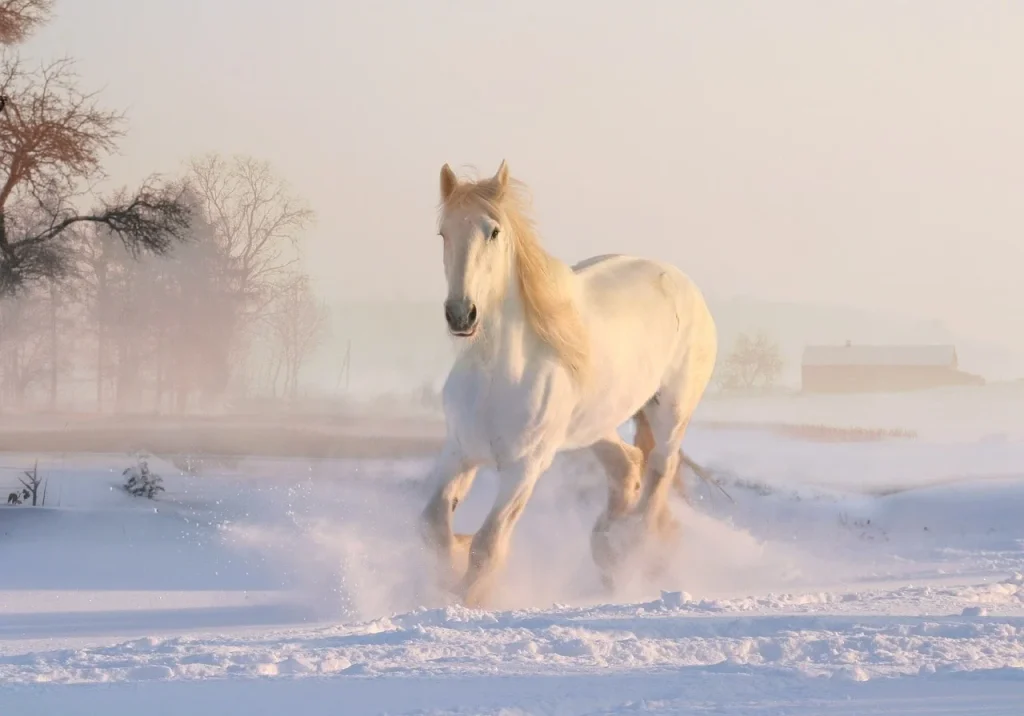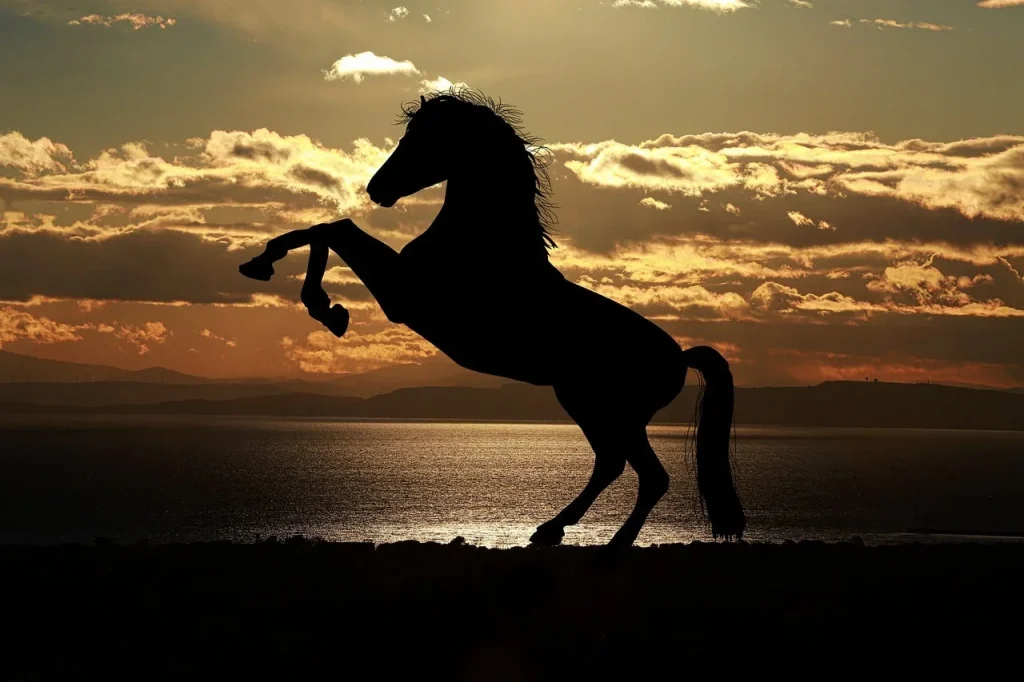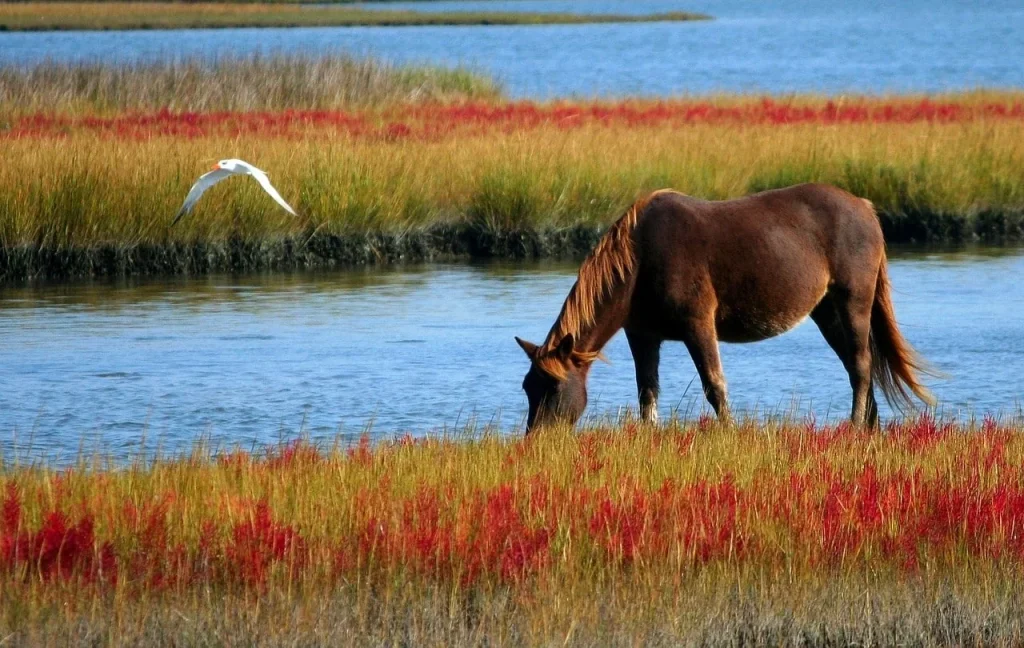What do you really know about horses? These majestic animals are not just about speed and beauty. There’s a whole world of interesting details waiting to be uncovered. Today, we’re diving into some surprising facts about horses that will give you a deeper appreciation for these beloved creatures.
Join us as we explore their amazing abilities, quirky behaviors, and the special role they play in cultures around the world.
A horse doesn’t care how much you know until he knows how much you care.
Pat Parelli
Horse Facts
As we gallop through the facts, keep your eyes peeled and your mind sharp! There’s a quiz at the end of this article to test whether you’re truly a horse expert.
- Horses have the largest eyes of any land mammal.
- These animals can run within hours after birth.
- They use their ears, eyes, and nostrils to express their mood.
- Equines can see nearly 360 degrees around due to eye placement.
- An adult’s heart weighs about nine pounds.
- Their memories are exceptionally strong, rivaling that of elephants.
- Zebras and donkeys can interbreed with them, creating zorses and mules.
- Przewalski’s horse is the only truly wild breed that has never been domesticated.
- These animals can sleep both lying down and standing up thanks to a special locking mechanism in their legs.
- The hoof is made of the same protein that comprises human hair and fingernails.
- They have an excellent sense of balance, thanks to a well-developed vestibular system.
- Domestic breeds can live to be over 30 years old.
- Genetic testing indicates that all modern members of the species derive from two main ancestral lines.

- They produce approximately 10 gallons of saliva per day.
- The Akhal-Teke from Turkmenistan is known for its metallic sheen.
- A group’s leadership is usually female.
- Unlike humans, they can breathe only through their nose.
- Foals are born with a special layer of hair called foal fuzz that disappears with age.
- They have been depicted in art for thousands of years, with some cave drawings being over 30,000 years old.
- Survival instinct is so strong they can bolt if frightened and remember dangerous locations for years.
- Some breeds, like the American Quarter Horse, excel in short-distance sprints, reaching up to 55 mph.
- Vocalizations such as whinnying or neighing are unique to each animal.
- A single hoof is strong enough to support hundreds of pounds of weight.
- They have a higher number of olfactory receptors and can smell better than humans.
- When moving, these animals synchronize their breathing with their stride.
- Ancient peoples revered the Mongolian wild horses, depicting them in numerous traditional stories.
- They can drink up to 10 gallons of water a day.
- Their spine structure is unique, allowing for a wide range of powerful movements.

- They recognize human facial expressions and voices to identify friends and caretakers.
- Psychologically, they are capable of feeling joy and sadness.
- Hormonal communication plays a critical role in herd dynamics.
- Their ancestors were much smaller, forest-dwelling creatures.
- Teeth take up a larger amount of space in their heads than their brains.
- Over 300 different breeds exist worldwide, each adapted to various needs and environments.
- Their ears can rotate almost 180 degrees, using 10 different muscles.
- Curly horses are hypoallergenic, making them suitable for people with allergies.
- The behavior of tail-wagging in these animals often signals irritation or discomfort.
- They have a unique ability to interact with humans, learning and performing complex tasks.

- During the Renaissance, noble families in Europe bred them to create powerful war horses.
- A healthy adult’s resting heart rate is about 30 to 40 beats per minute.
- Throughout history, different cultures have revered them as symbols of freedom and power.
- Their liver cannot process hay that is too rich in protein, requiring a balanced diet.
- Some breeds can trot as fast as other animals sprint.
- They communicate with other members of their species by snorting, which has various meanings based on the sound.
- Their stomachs function best when eating small amounts of food continuously throughout the day.
- Feral horses can adapt to almost any environment, from islands to mountains.
- Gestation lasts approximately 11 months, culminating in a single foal.
- A unique facial marking called a blaze can help identify individuals.
- Endurance races can see them covering 100 miles in one day.
- Their ability to cope with extreme temperatures varies significantly across breeds.
Horse Myths

Now that we’ve explored the fun facts about horses, let’s dive into the next section where we separate truth from myth.
- Horses Cannot Sleep Standing Up
They are often seen standing while asleep due to a special mechanism in their legs called the “stay apparatus,” which allows them to lock their limbs and relax without falling over. - Horses Only Eat Grass
While grass is a fundamental part of a horse’s diet, their nutritional needs are supplemented with grains, fruits, and vegetables to ensure a balanced intake of nutrients. - Horses Have a Poor Memory
Contrary to this myth, they are actually known for their excellent memory. It is believed by many that they can remember places, other horses, and humans for years. - A Horse’s Age Can Be Known by Its Teeth
Although the general age of a horse can be estimated by examining its teeth, this method is not precise. The wear and growth of teeth can be influenced by diet and usage, making exact aging challenging. - Horses Are Colorblind
They are not colorblind, but their color vision is different from humans. It is generally understood that they can see blues and greens but may have difficulty distinguishing between red and green.
Horse Quotes

Let the following quotes illuminate the profound connection between humans and horses. Feel free to share more in the comments so I can add them to the list.
The horse is God’s gift to mankind.
Arabian Proverb
This Arabian proverb highlights the horse’s value and significant role throughout human history, particularly in Arab culture.
No hour of life is wasted that is spent in the saddle.
Winston Churchill
Winston Churchill, a passionate horseman, reflects on the joy and fulfillment that riding brings to life.
There is something about the outside of a horse that is good for the inside of a man.
Winston Churchill
Another quote from Churchill, this time acknowledging the therapeutic and soul-soothing effects horses can have on people.
Horses make a landscape look beautiful.
Alice Walker
Alice Walker, the Pulitzer Prize-winning author, appreciates horses not just for their utility but also for the aesthetic enhancement they bring to nature.
I’ve often said there is nothing better for the inside of the man, than the outside of the horse.
Ronald Reagan
Ronald Reagan, the 40th President of the United States and a former actor, echoes a sentiment similar to Churchill’s, praising the profound impact that interacting with horses can have on a person’s well-being.
Horse FAQ

We are getting closer to the quiz, but first it’s the FAQ section. Read carefully these questions if you want to score a perfect ten at the upcoming trivia.
- Can horses swim?
Yes, they can swim! Many horses are natural swimmers and can move through water using a paddle-like motion with their legs. Swimming can be a great exercise for them, helping to build muscle and stamina without putting too much strain on their joints. - Why do horses need horseshoes?
They wear horseshoes to protect their hooves from wear and tear. Since domestic horses often walk on harder and rougher surfaces than they would in the wild, horseshoes help prevent their hooves from wearing down too quickly, keeping them in good shape and helping to prevent injuries. - How do horses communicate?
They communicate through a combination of vocal sounds, body language, and facial expressions. They whinny, neigh, and snort to express emotions and intentions. Additionally, they use ear positions, tail movements, and other body signals to convey messages to other horses and humans. - Why do horses wear blinders?
They wear blinders (also known as blinkers) to keep them focused and prevent distractions. Blinders block the horse’s peripheral vision, which helps them concentrate on what is in front of them, especially in crowded or noisy environments. This is particularly useful in racing and carriage-driving. - Are horses native to America?
They originally evolved in North America, but they went extinct on the continent around 10,000 years ago. The horses we see today in the Americas were reintroduced by European settlers in the 15th and 16th centuries. These reintroduced horses quickly adapted to various environments, becoming an integral part of many cultures across the continent.
Horse Trivia

Welcome to the ultimate horse quiz! Saddle up your knowledge, because if you don’t get any questions right, you might just find yourself volunteering at the ‘pooper scooper’ brigade at the nearest stable!
Conclusion
Finally, horses are not just animals; they are symbols of strength, freedom, and grace. As we’ve seen, their abilities and characteristics are as varied as their breeds. They teach us about resilience and the beauty of forming strong, respectful relationships with other beings.
Whether you ride, own, or simply love watching these beautiful animals, there’s always something enchanting about horses. Let’s continue to cherish and protect them. Till next time, stay curious and explore more. Cheers.


